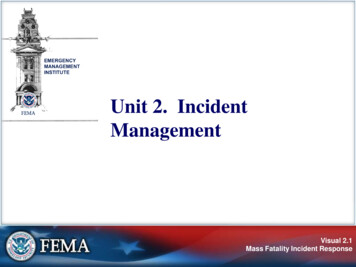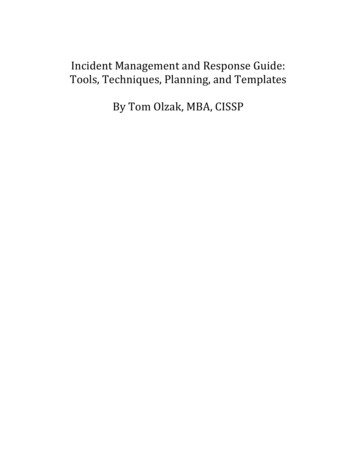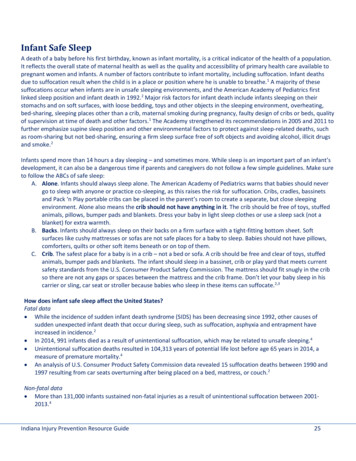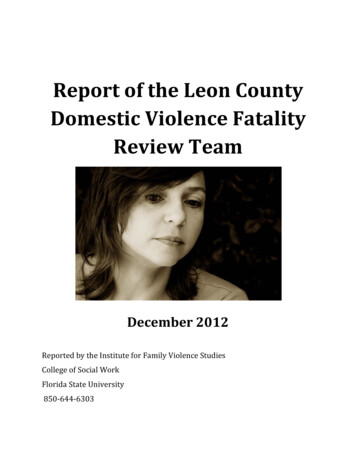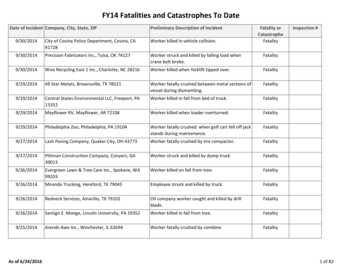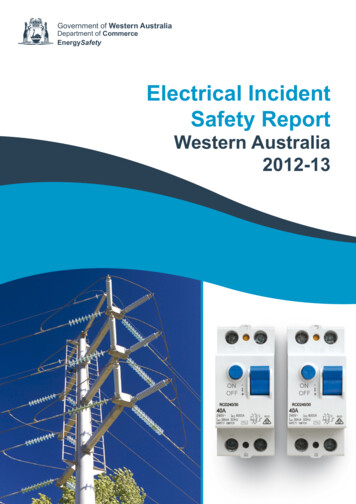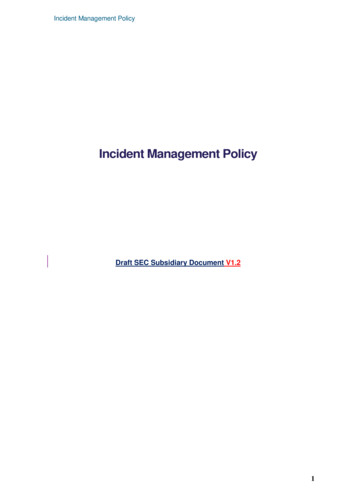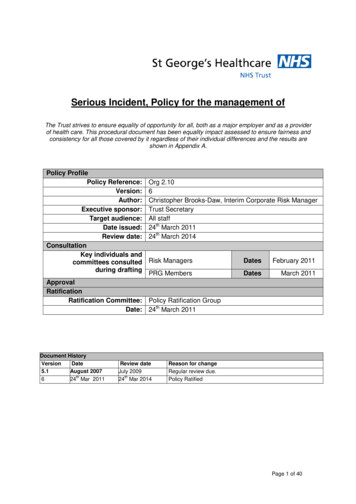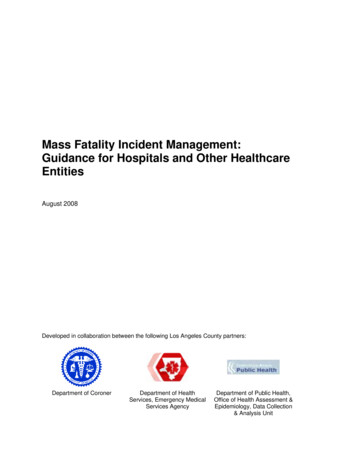
Transcription
Mass Fatality Incident Management:Guidance for Hospitals and Other HealthcareEntitiesAugust 2008Developed in collaboration between the following Los Angeles County partners:Department of CoronerDepartment of HealthServices, Emergency MedicalServices AgencyDepartment of Public Health,Office of Health Assessment &Epidemiology, Data Collection& Analysis Unit
Los Angeles County Mass Fatality Incident Management: Guidance for Hospitals and Other Healthcare EntitiesTABLE OF CONTENTSSECTION 1: OVERVIEWPurpose . 2Assumptions. 3County-Wide Coordination . 4Key Contacts. 5SECTION 2: HOSPITAL MASS FATALITY INCIDENT (MFI) PLANNINGPlanning Overview . 610 Questions to Get Started. 7Sample Table of Contents. 8Checklist: MFI Planning . 9SECTION 3: HOSPITAL MASS FATALITY INCIDENT (MFI) RESPONSEHospital Mass Fatality Incident (MFI) Management Unit . 13Job Action Sheet: MFI Unit Leader . 14Checklist: MFI Management Unit Equipment and Supplies. 17Card: Decedent Information and Tracking . 18Form: Fatality Tracking . 19SECTION 4: DEATH FLOW PROCESSDecedent Processing: Potential Bottlenecks . 20Flow Chart: Death at A Hospital. 21Flow Chart: Pandemic Influenza Death at A Hospital. 22SECTION 5: DEATH CERTIFICATESFact Sheet: About Death Certificates and Facts About Signing the Death Certificate . 23Flow Chart: Death Certificate Process. 24Sample: Form VS-11E Certificate of Death . 25Fact Sheet: California Electronic Death Registration System (CA-EDRS). 26Fact Sheet: Information on the LAC Public Administrator . 27SECTION 6: DECEDENT HANDLING AND STORAGEFact Sheet: Health Risk from Dead Bodies and Basic Infection Control for Staff Handling Dead Bodies 28Fact Sheet: Human Remains Storage Myths and Truths . 29Fact Sheet: Decomposition . 32Fact Sheet: Recommended Methods of Storage for Hospitals. 33Checklist: Surge Morgue Equipment and Supplies . 34SECTION 7: ADDITIONAL RESOURCESMass Fatality Pandemic Influenza Exercise Sample Pre and Post Test Questions. 35Web Resources. 37August 20081
Los Angeles County Mass Fatality Incident Management: Guidance for Hospitals and Other Healthcare EntitiesPURPOSEA mass or multi-fatality incident (MFI) results in a surge of deaths above what is normally managed bynormal medicolegal systems. In the event of a major disaster within Los Angeles County, it may beseveral days before the Department of Coroner, County Morgue, or private mortuaries can respond,process and recover decedents. The following guidelines have been developed to aid hospitals and otherhealthcare entities in their response to an MFI.While this guidance is intended for use during a county-wide MFI, the principles can be applied anytime ahospital is experiencing a surge of deaths above what is normally managed by the hospital. Theseprinciples can also be used by any healthcare entity of any size to manage an MFI. The forms andchecklists are designed to be personalized by your facility as needed.This guidance includes information on preserving and safeguarding decedents, property, and evidence. Itwill also discuss the processes and issues for decedent identification, next of kin notification, deathcertificate processing, tracking, storage, and final disposition.The goal of these guidelines is to enhance the ability of Los Angeles County and its healthcare partnersto respond to and manage a surge in the number of decedents as a result of any disaster, including aninfluenza pandemic. While the importance of religious, cultural and mental health considerations isrecognized, it is not addressed here. These guidelines focus on decedent processing for medical andlegal reasons.This guidance was developed in collaboration between the Los Angeles County Department of Coroner,Department of Health Services, Emergency Medical Services Agency (EMS), and Department of PublicHealth, Office of Health Assessment & Epidemiology, Data Collection & Analysis Unit. This document isavailable for download at the EMS Web site: http://ems.dhs.lacounty.gov/.August 20082
Los Angeles County Mass Fatality Incident Management: Guidance for Hospitals and Other Healthcare EntitiesASSUMPTIONS The Los Angeles County Department of Public Health registers approximately 57,000 deaths/year. It is the duty of the Department of Coroner to determine the circumstances, manner and cause of allviolent, sudden, or unusual deaths. A mass or multi fatality incident (MFI) results in a surge of deaths above which is normally managedby a community’s usual medicolegal system. The Los Angeles County Department of Coroner is the lead agency to manage an MFI, however it isnot solely responsible for all aspects of response to an MFI. Medicolegal systems may continue to experience a “normal” case load as well as the case load fromthe MFI with the possibility of an increase in accidental deaths (due to therapeutic complicationsand/or those resulting from the increased use and operation of motor vehicles/heavy equipment),homicidal (due to civil unrest), and/or suicide cases. The Department of Coroner, Department of Health Services, Department of Public Health, hospitalsand other healthcare entities have limited fatality surge space or equipment. Federal or military assistance in fatality management may not be available to local jurisdictions inwidespread incidents such as a pandemic. Disposition of human remains requires a death certificate. In all US jurisdictions, a treating or primary care physician is authorized to sign a death certificateprovided the patient dies from natural causes and has knowledge of the causes of death. Human remains do not pose additional health risks to the community. Those who physically handle remains may be at risk of blood borne or body fluid exposure requiringuniversal precautions and proper training for handling the dead. It is more important to ensure accurate and complete death investigations and identification of thedead than it is to quickly end the response. The time to complete fatality management of a mass fatality event may exceed six months to a year. Mental health professionals, social service organizations and religious leaders will have to beeducated in the mass fatality management process at all levels to ensure the process is understoodand can be properly communicated to the general population in their response activities.August 20083
Los Angeles County Mass Fatality Incident Management: Guidance for Hospitals and Other Healthcare EntitiesCOUNTY-WIDE COORDINATIONMass fatalities may occur as the result of a variety of events, including natural disasters or diseaseoutbreaks, large accidental incidents, or as the result of the intentional use of a chemical, biological,radiological, or explosive agent. Since an MFI is likely to result from a major incident, the Los AngelesCounty (LAC) Sheriff’s Department has overall responsibility for managing the incident response, and theLAC Office of Emergency Management has overall responsibility for managing recovery.The Department of Coroner is the lead agency on fatality management during a disaster, and has anestablished Emergency Response Plan. Included is an MFI Plan that outlines the actions to be taken bythe Coroner and its relationships (via the Standardized Emergency Management System and IncidentCommand System) with the Operational Area (Los Angeles County), local, state and federal lawenforcement, fire, hazmat, LAC Department of Public Health Data Collection and Analysis Unit, on suchtopics as team deployment, equipment, scene assessment, decedent transport, examining andprocessing, and body storage options. (Note: Federal or military assistance in fatality management maynot be available to local jurisdictions in widespread incidents such as a pandemic.)Each disaster scenario presents specific considerations, however all sudden and unexpected deaths aswell as traumatic deaths fall under Coroner jurisdiction. A community-wide MFI, especially one due to adisease outbreak or other public health emergency may also fall under the jurisdiction of the Public HealthOfficer. Hospitals should stay alert for supplemental guidance on identifying the underlying cause ofdeath or other significant conditions contributing to death. This information may be issued from theDepartment of Coroner or the Department of Public Health.Hospitals will continue to interact and receive incident updates with Los Angeles County through the LACDepartment of Health Services Emergency Medical Services Agency via established systems includingthe Medical Alert Center, ReddiNet, Hospital Emergency Administrative Radio (HEAR), and with theDepartment of Public Health through usual channels such as the Acute Communicable Disease ControlHospital Outreach Unit or the Health Alert Network (HAN).August 20084
Los Angeles County Mass Fatality Incident Management: Guidance for Hospitals and Other Healthcare EntitiesKEY CONTACTSLos Angeles County Department of Coroner 24/7: 323-343-0714 Renee GrandPre, Disaster Coordinator, RGrandPre@coroner.lacounty.govLos Angeles County Department of Health Services Emergency Medical Services Agency General: 562-347-1500 24/7 Medical Alert Center (MAC) o323-722-8073oOn Sept 02, 2008, the number changes to 866-940-4401http://ems.dhs.lacounty.govLos Angeles County Department of Public HealthAcute Communicable Disease Control For biological incident reporting, including suspect pandemic influenza Business Hours (Mon-Fri, 8:00am-5:00pm): 213-240-7941 After Hours: 213-974-1234Data Collection and Analysis Unit 213-240-7785; http://www.lapublichealth.org/dca Vital Records Office: 213-240-7816 (deaths)Los Angeles County Morgue / Decedent Affairs 323-226-7161Los Angeles County Public Administrator’s Office General: 213-974-0404 Investigation Unit: 213-974-0460 http://ttc.lacounty.gov/Proptax/PA openning.htmCalifornia Electronic Death Registration System (EDRS) Helpdesk 916-552-8123 https://ca.edrs.us (CA-EDRS login page)August 20085
Los Angeles County Mass Fatality Incident Management: Guidance for Hospitals and Other Healthcare EntitiesHOSPITAL MFI PLANNING OVERVIEWJoint CommissionWhile conducting hospital MFI planning is prudent and should be a part of all emergency managementplans and emergency operations plans, it is also a new element in the 2008 Joint CommissionEnvironment of Care Emergency Management Standards, EC.4.18: The organization establishesstrategies for managing clinical and support activities during emergencies, specifically EC.4.18.5: Theorganization plans to manage the following during emergencies: mortuary services.In 2009, MFI planning will be incorporated in the Emergency Management Chapter and included inStandard EM.02.02.11 which states that as part of its Emergency Operations Plans, the organizationprepares for how it will manage patients during emergencies. Specifically in EM.02.02.11.7, theperformance measure states that the Emergency Operations Plan describes the following: How thehospital will manage mortuary services.Hospital Preparedness ProgramAccording to US Department of Health and Human Services Hospital Preparedness Program guidance(Target Measure H4.1), all HPP-funded hospitals will have a finalized written plan for mass fatalitymanagement by August 08, 2009. A finalized written plan is one that has received senior managementapproval. This plan should include at minimum, current information on (a) trained and availablepersonnel; (b) equipment, supplies, facilities, and other material resources; and (c) operational structureand standard operating procedures for disposition of the deceased.Review Existing Hospital Resources and Plans/Policies/PracticesAs part of the planning process, identify existing resources and procedures in place for the managementof deaths at your facility. This may include your Decedent Affairs or Medical Records departments. Staffmay already be familiar with and regularly use common forms such as the LAC Department of CoronerForm 18: Hospital and Nursing Home Facility Report and Form VS-11: Certificate of Death. They mayalready be trained on using the Electronic Death Registration System (EDRS). Also identify any formal orinformal mass fatality or fatality surge plans that you may have. These may include memoranda ofunderstanding (MOUs) with local mortuaries or refrigeration container companies. Many facilities haveinformal plans on managing a surge of fatalities, and these should be converted to written plans.Develop a Written PlanThe included Hospital MFI Plan checklist (see page 9) can be used to evaluate a current MFI plan orprovide guidance in developing an MFI plan. And as always, be sure to train to and exercise the plan.The fact sheets and flow charts included in this guidance may be helpful when developing the plan and inconducting trainings.August 20086
Los Angeles County Mass Fatality Incident Management: Guidance for Hospitals and Other Healthcare EntitiesHOSPITAL MFI PLANNING: 10 QUESTIONS TO GET STARTED“Death does not end human suffering, especially when death is sudden, as the result of a disaster. Thedeath of a loved one leaves an indelible mark on the survivors, and unfortunately, because of the lack ofinformation, the families of the deceased suffer additional harm because of the inadequate way that thebodies of the dead are handled. These secondary injuries are unacceptable, particularly if they are theconsequence of direct authorization or action on the part of the authorities or those responsible forhumanitarian assistance.” Mirta Roses Periago, Director, Pan American Health Organization1. What are the decedent management priorities of your organization? What key assumptions are thesepriorities based upon?2. Does your organization have a written mass fatality plan in place? If so, who has the authority toactivate these plans and/or procedures, and have you trained to the plan?3. Do you have staff and resources identified that will be dedicated to mass fatality incidentmanagement?4.What are the possible bottlenecks in the decedent processing procedures? Have any solutions beendeveloped and/or implemented to mitigate these issues?5. What is the capacity of your morgue? Do you have alternate on-site and off-site surge morguecapacity? Do you have memoranda of understanding in place (if applicable)?6. Do you have staff and resources identified that will be dedicated to surge morgue management?7. To what extent can technology assist with decedent processing?8. Who in your organization or jurisdiction has the authority to make the decision to alter or change thecurrent decedent processing and identification plan?9. What legal hurdles, if any, does your organization or jurisdiction face when executing your massfatality incident plan? How will your organization and jurisdiction deal with them to ensure that theprocessing of decedents is not delayed or otherwise stalled by legal matters?10. What reputation management issues could arise if your facility does not adequately manage a massfatality incident?August 20087
Los Angeles County Mass Fatality Incident Management: Guidance for Hospitals and Other Healthcare EntitiesHOSPITAL MFI PLANNING: SAMPLE TABLE OF CONTENTS1) Purpose, Scope, and Assumptions2) Plan Activation Triggers and Procedures3) Mass Fatality Incident Managementa) MFI Management Uniti)Staffing Needs and Assignmentsii)Locationiii) Equipment and Suppliesb) Procedures for Decedent Identification and Trackingc) Procedures for Death Certificate Completion and EDRSd) Procedures for Custody of Personal Property and Evidencee) Formsf)Relationship with external/community partners4) Human Remains Managementa) Staffing Needs and Assignmentsb) Normal morgue capacityc) On-site surge morgue capacityi)Location, including assessmentsii)Capacity and manner of storageiii) Triggers for activation and demobilizationd) Off-site surge morgue capacityi)Location, including assessmentsii)Capacity and manner of storageiii) Triggers for activation and demobilizationiv) Memoranda of Understanding, Agreement, or Contractse) Procedures for Human Remains Storagef)Equipment and Suppliesg) Infection Control Policyh) Security5) Psychosocial Considerations6) Plan Evaluationa) Revision Processb) Training and Exercise Program7) Related Emergency Management Program Documents8) References and ResourcesAugust 20088
Los Angeles County Mass Fatality Incident Management: Guidance for Hospitals and Other Healthcare EntitiesHOSPITAL MFI PLANNING: CHECKLISTThis checklist was developed to help hospitals prepare and respond to a mass fatality incident regardlessof cause. It is designed to be adapted to meet the unique needs and circumstances of your facility, andcan be used as a tool for developing or evaluating MFI plans.1. Written MFI PlanCompletedInProgressNotStartedActionsMFI planning has been incorporated into disaster planningand exercises for the hospital.A written MFI plan has been developed.Primary and backup responsibility has been assigned forcoordinating MFI planning.Primary (Name, Title and Contact info):Backup (Name, Title and Contact info):A multidisciplinary planning committee has been identifiedspecifically to address MFI planning exercising.Members of the MFI planning committee may include: Hospital administration Disaster coordinator Morgue operations Decedent affairs Medical records Infection control/hospital epidemiology Laboratory services Occupational health Legal counsel/risk management Public relations coordinator/public information officer Engineering and maintenance Environmental (housekeeping) services Central (sterile) services Security Information technology Expert consultants (e.g., ethicist, mental/behavioral healthprofessionals, LCSWs) Other member(s) as appropriate (e.g., clergy, localcoroner, medical examiner, morticians)August 20089
Los Angeles County Mass Fatality Incident Management: Guidance for Hospitals and Other Healthcare Entities1. Written MFI PlanCompletedInProgressNotStartedActionsPoints of contact for information on MFI planning resourceshave been identified within local government. LAC Dept of Coroner: Renee GrandPre, DisasterCoordinator, RGrandPre@coroner.lacounty.gov LAC DHS EMS Agency, Disaster Management Unit, 562347-1500The MFI plan identifies the trigger to activate the MFI PlanThe MFI plan identifies the person(s) authorized to implementthe plan and the organizational structure that will be used,including the delegation of authority to carry out the plan 24/7.The MFI plan includes a mass fatality incident managementunit or similar management unit/team.Responsibilities of key personnel and departments within thefacility related to executing the plan have been described.Personnel who will serve as back-up (e.g., B team) for keypersonnel roles have been identified.The MFI plan indicates to notify the LAC EMS Agency via theMedical Alert Center (866-940-4401) or ReddiNet, and who isresponsible for making the notification.Tabletop exercise and/or other exercises have beenconducted to test the plan.Date performed:Date performed:A full scale drill/exercise has been developed to test the plan.Date performed:The plan is updated regularly and includes current contactinformation and lessons learned from exercises and drills.A list of mental/behavioral health, community and faith-basedresources that will be available to provide counseling topersonnel during an MFI.2. Mass Fatality Incident Management UnitCompletedInProgressNotStartedActionsThe plan identifies who is the lead to implement the hospital’sMFI Plan. (Is this person the MFI Unit Leader?)Staff trained on EDRS have been identified.Location of the MFI Unit Administrative section has beenidentified.August 200810
Los Angeles County Mass Fatality Incident Management: Guidance for Hospitals and Other Healthcare Entities2. Mass Fatality Incident Management UnitCompletedInProgressNotStartedActionsEquipment and supplies have been identified and/or procuredfor the MFI Unit Administrative section (review MFIManagement Unit Equipment/Supplies Checklist on page 17).A process has been developed to identify decedents (such astaking a photo or fingerprint upon admission or immediatelyupon death) and maintaining records of the information (seesample Decedent Tracking Card on page 18).A process has been developed to track decedents (such asusing a database, a tracking form (see page 19), or inputinginto ReddiNet (if available).Responsibility has been assigned for maintainingcommunication with the hospital command center to receivemortality estimates in order to anticipate and supply neededadministrative and morgue equipment.Responsibility has been assigned for communications withLAC Dept of Public Health (ACDC, Vital Records, or asneeded) and monitoring public health advisories.Responsibility has been assigned for communications withLAC Dept of Health Services (EMS, MAC, ReddiNet, or asneeded).Responsibility has been assigned for communications withcoroner authorities (i.e., case reporting, status updates) duringa disaster.Responsibility has been assigned for communications withnext of kin.A protocol has been established to identify and protectdecedent personal property and maintain chain of custody ifidentified as evidence. The Decedent Tracking Card (page18) or similar form can be used to catalog this information.3. Morgue SurgeCompletedInProgressNotStartedActionsThe plan identifies current morgue capacity: # and location(can also be labeled something like Primary Morgue)Identify surge capacity: # and locations (can also be labeledsomething like Secondary or Surge Morgues).May also identify a tiered level with triggers to add or changemorgue locations. This may be a result of the number ofdecedents (escalation and de-escalation), new resourcesavailable, the viability of the current location, etc.August 200811
Los Angeles County Mass Fatality Incident Management: Guidance for Hospitals and Other Healthcare Entities3. Morgue SurgeCompletedInProgressNotStartedActionsIdentify staff resources that may be needed (review MorgueTask Force recommendations on page 13)Identify supplies and equipment needed (review SurgeMorgue Equipment and Supplies Checklist on page 34).A protocol has been developed to rapidly identify the locationof where decedents are stored. For example, each decedentwill have an ‘address’ such as Morgue Room 1, Row 2, # 5, orother such nomenclature.An infection control policy that requires morgue personnel touse Standard PrecautionsHospital security personnel have input into procedures and aplan for securing access to morgue areasAugust 200812
Los Angeles County Mass Fatality Incident Management: Guidance for Hospitals and Other Healthcare EntitiesHOSPITAL MASS FATALITY INCIDENT (MFI) MANAGEMENT UNITThe purpose of a Hospital MFI Management Unit is to have a centralized location where all mass fatalityinformation is being processed in your facility in response to a mass-casualty event, pandemic outbreak,terrorist attack, or large natural disaster. Functions include: Decedent identification (if not already done upon admittance) Family / next of kin notification Coroner, County morgue or mortuary notification/contact Tracking decedents who die in the hospital to disposition out of the hospital Managing morgue capacity Managing surge morgue capacityIt is suggested that the MFI Unit be located in the HICS Operations Section Medical Care Branch, andthat the MFI Unit Leader reports directly to the Medical Care Branch Director. The MFI Unit willcoordinate information with the Patient Registration Unit and the Casualty Care Unit, particularly for thosepatients identified as expectant. The MFI Unit will also coordinate information with the Planning SectionSituation Unit Patient Tracking Manager. During a disaster, it may not be possible for your facility to staffall positions, however they are identified here to help illuminate the roles and responsibilities that shouldbe addressed.In addition to a MFI Unit Leader (see page 14 for a sample Job Action Sheet), recommended essentialdisciplines are identified in the table. Due to the sensitive nature of decedent processing, ensure all staffreceive psychological support if needed. Be cautious in the use of hospital volunteers who may not havehad experience or exposure to mass fatality situations.Administrative Task ForceMorgue Task Force Decedent identification staffDecedent tracking staffLiaison to HICS Patient Tracking Officer and other HCCcontactsData entry staff to ReddiNet and EDRSLiaison to LAC DPH, other relevant County agencies, andmortuariesLiaison to familiesDeath Certificate coordinator (a physician with responsibilityto coordinate with other physicians to ensure deathcertificates are signed to expedite decedent processing)IT supportAugust 2008 Morgue supervisor1-2 morgue assistants(Minimum of two morgue taskforce members to safely movedecedents)Infection control staff, as neededMorgue staff to maintain eachmorgue areaFacilities/engineering to maintainthe integrity of surge morgueareasSecurity for all morgues13
Los Angeles County Mass Fatality Incident Management: Guidance for Hospitals and Other Healthcare EntitiesMFI UNIT LEADERJOB ACTION SHEETMission: Collect, protect, identify and track decedents.Date: Start: End: Position Assigned to: Initial:Position Reports to: Medical Care Branch DirectorSignature:Hospital Command Center (HCC) Location: Telephone:Fax: Other Contact Info: Radio Title:Immediate (Operational Period 0-2 Hours)TimeInitialReceive appointment and briefing from the Medical Care Branch Director. Obtain MFIUnit activation packet.Read this entire Job Action Sheet and review incident management team chart (HICSForm 207). Put on position identification.Notify your usual supervisor of your HICS assignment.Determine need for and appropriately appoint MFI Unit staff, distribute correspondingJob Action Sheets and position identification. Complete a unit assignment list.Document all key activities, actions, and decisions in an Operational Log (HICS Form 214)on a continual basis.Brief MFI Unit staff on current situation; outline unit action plan and designate time fornext briefing.Confirm the designated MFI Unit area is available, and begin distribution of personneland equipment resources. Coordinate with the Medical Care Branch Director.Regularly report MFI Unit status to Casualty Care Unit Leader.Assess problems and needs; coordinate resource management.Use your Death Certificated Coordinator physician or request an on-call physician fromthe Casualty Care Unit Leader to confirm any resuscitatable casualties in Morgue Area.Obtain assistance from the Medical Devices Unit Leader for transporting decedents.Assure all transporting devices are removed from under decedents and returned to theTriage Area.Instruct all MFI Unit Task Force members to periodically evaluate equipment, supply,and staff needs and report status to you; collaborate with Logistics Section Supply UnitLeader to address those needs; report status to Medical Care Branch Director.Coordinate contact with external agencies with the Liaison Officer, if necessary.Monitor decedent identification process.Enter decedent information in ReddiNet, if appropr
The Department of Coroner is the lead agency on fatality management during a disaster, and has an established Emergency Response Plan. Included is an MFI Plan that outlines the actions to be taken by . The included Hospital MFI Plan checklist (see page 9) can be used to evaluate a current MFI plan or provide guidance in developing an MFI plan .
